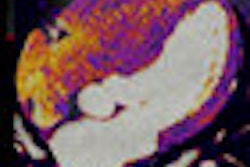Computer-aided detection (CAD) technology shows promise for helping radiologists diagnose pulmonary embolism (PE) on CT pulmonary angiography (CTPA) exams, according to research from the University of Michigan in Ann Arbor.
Although it provided a high number of false-positive findings in the retrospective study, the institution's internally developed CAD software prototype yielded 80% sensitivity and was able to detect a number of PEs missed by two radiologists, the researchers found.
"The CAD system detected PEs not marked by the radiologists, demonstrating the potential for assisting the radiologist in PE detection," said Chuan Zhou, PhD. He presented the findings during a scientific session at the 2010 RSNA meeting in Chicago.
As part of their goal of developing a CAD system to assist radiologists in detecting PE on CTPA images, the researchers sought to establish a reference standard for testing and training the CAD system. A key step for CAD development, the reference standard utilizes manual marking of PE by radiologists.
However, previous studies, such as the Lung Image Database Consortium (LIDC), have found wide variability in radiologists' detection and segmentation of lung nodule boundaries on CT images, Zhou told AuntMinnie.com.
Therefore, the study team wanted to explore the variability of radiologist-identified PE locations and investigate the potential benefit of CAD. Forty CTPA PE cases were retrospectively selected from the institution's patient files. All patients received CT scanning on a four- or 16-slice CT scanner with image reconstruction at 1.25-mm intervals, Zhou said.
In the first phase of the study, two experienced thoracic radiologists independently evaluated each case and marked PE locations. If a PE occluded more than one branch of the arteries, the radiologist virtually split the single PE segment into two separate volumes, which were considered each to be PE, according to the researchers.
In cases in which the radiologists did not agree, each radiologist reread the case to reach a consensus finding. The first radiologist marked 444 PEs in the 40 PE cases, while 500 PEs were identified by the second radiologist. After differing on 101 marks in 36 cases, the radiologists reread the studies in consensus and decided that 65 of the marks were true PEs and 36 were false positives. The researchers considered this dataset to be the reference standard.
After the researchers applied their prototype CAD system to the 40 cases, the CAD marks were examined to determine if any true PEs were not included in the reference standard.
The CAD software yielded a test sensitivity of 80% and an average of 22.6 false positives per case. It also found 17 PEs that were false negatives for both radiologists and six PEs that were missed by one of the readers.
In other findings related to the reference standard, the researchers noted that of the 65 marks determined in consensus to be true PEs, the first radiologist had 48 that were considered to be false negatives and the second radiologist had 17. The first radiologist had 14 false positives, while the second had 22.
The researchers determined interobserver agreement to be 0.903 ± 0.04 with a κ-value of 0.613.
"[There was] substantial agreement between two radiologists' markings of PEs, but consensus with two radiologists improved the reference standard," Zhou said.
Zhou said that further studies are under way to improve the reference standard. The authors also are working to increase the CAD algorithm's sensitivity and reduce false positives caused in veins (by separating arteries and veins), in arteries within the lung disease area, and those attributed to partial volume effect and other artifacts, Zhou said.
By Erik L. Ridley
AuntMinnie.com staff writer
January 11, 2011
Related Reading
Automated PE protocol tool optimizes contrast use, image quality, November 29, 2010
Bundling of CAD software boosts lung lesion detection at CT, September 21, 2010
PE risk factor assessment reduces need for CT angiograms, June 16, 2010
Consider screening DVT patients for silent pulmonary embolism: review, May 14, 2010
CAD offers value in detecting pulmonary embolism, March 26, 2010
Copyright © 2011 AuntMinnie.com



















